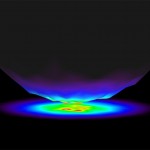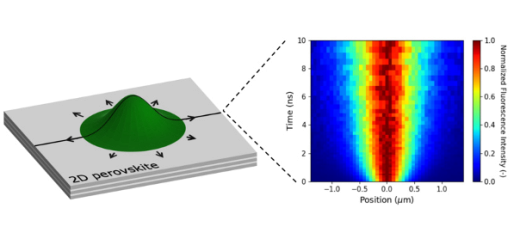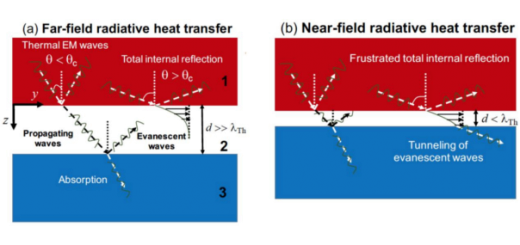Radiative Heat Transfer In The Extreme Near Field

Calculated distribution of the radiative heat transfer between a SiO2 AFM tip and a SiO2 substrate separated by a few nanometers.
Article: published in Nature by Víctor Fernández-Hurtado, Johannes Feist, Francisco J. García-Vidal and Juan Carlos Cuevas, Department of Theoretical Condensed Matter Physics and IFIMAC researchers.
Radiative heat transfer between objects at different temperatures is of fundamental importance in applications such as energy conversion, thermal management, lithography, data storage, and thermal microscopy. It was predicted long ago that when the separation between objects is smaller than the thermal wavelength, which is of the order of 10 µm at room temperature, the radiative heat transfer could be greatly enhanced over the theoretical limit set by the Stefan-Boltzmann law for blackbodies. This is possible due to the contribution of the near field in the form of evanescent waves (or photon tunneling). In recent years, different experimental studies have confirmed this long-standing theoretical prediction. However, and in spite of this progress, recent experiments exploring the radiative thermal transport in nanometric gaps have seriously questioned our present understanding of thermal radiation at the nanoscale. In particular, these experiments cast some doubt on the validity of fluctuational electrodynamics, which is presently the standard theory for the description of near-field radiative heat transfer (NFRHT).
This fundamental puzzle has now been resolved in a work published in Nature by a collaboration between the groups of Pramod Reddy and Edgar Meyhofer (University of Michigan), the IFIMAC researchers Víctor Fernández-Hurtado, Johannes Feist, Francisco J. García-Vidal and Juan Carlos Cuevas, and Homer Reid (Massachusetts Institute of Technology). In this work, the authors used a novel type of scanning thermal probes with embedded thermocouples to measure the NFRHT between different materials (dielectrics and metals) down to gaps as small as 2 nm. In particular, it was shown how heat transfer between silica-silica, silicon nitride-silicon nitride and gold-gold surfaces exhibits a dramatic enhancement as the gap is reduced down to a few nanometers. Moreover, state-of-the-art simulations using the framework of fluctuational electrodynamics were able to reproduce all the experimental observations without any adjustable parameters. These results unambiguously demonstrate that fluctuational electrodynamics based on Maxwell’s equations provides an accurate description of the NFRHT between both metals and dielectrics all the way down to nanometer-size gaps. This work clarifies the fundamental mechanisms that govern the radiative heat transfer at the nanoscale and establishes a firm basis for the future design of novel technologies that make use of nanoscale radiative heat transfer. [Full article]



















